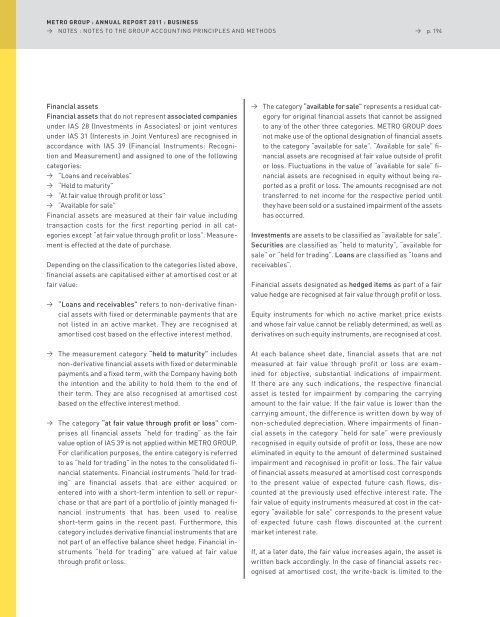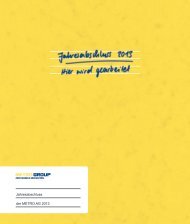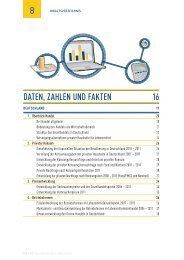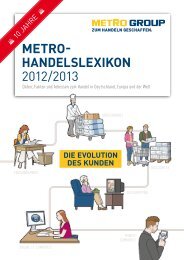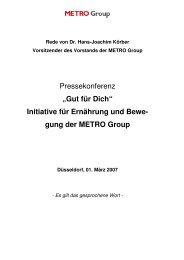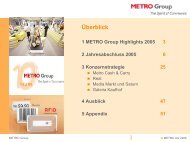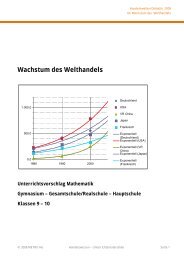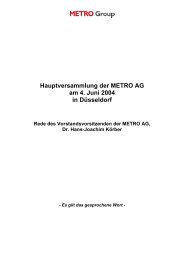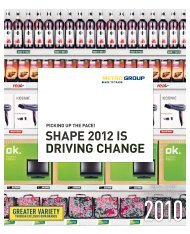pdf (22.8 MB) - METRO Group
pdf (22.8 MB) - METRO Group
pdf (22.8 MB) - METRO Group
You also want an ePaper? Increase the reach of your titles
YUMPU automatically turns print PDFs into web optimized ePapers that Google loves.
<strong>METRO</strong> gROUP : ANNUAL REPORT 2011 : BUsiNEss<br />
→ noTes : noTes To THe GRoUp aCCoUnTInG pRInCIples anD MeTHoDs<br />
Financial assets<br />
Financial assets that do not represent associated companies<br />
under Ias 28 (Investments in associates) or joint ventures<br />
under Ias 31 (Interests in Joint ventures) are recognised in<br />
accordance with Ias 39 (Financial Instruments: Recognition<br />
and Measurement) and assigned to one of the following<br />
categories:<br />
→ “loans and receivables”<br />
→ “Held to maturity”<br />
→ “at fair value through profit or loss”<br />
→ “available for sale”<br />
Financial assets are measured at their fair value including<br />
transaction costs for the first reporting period in all categories<br />
except “at fair value through profit or loss”. Measurement<br />
is effected at the date of purchase.<br />
Depending on the classification to the categories listed above,<br />
financial assets are capitalised either at amortised cost or at<br />
fair value:<br />
→ “Loans and receivables” refers to non-derivative financial<br />
assets with fixed or determinable payments that are<br />
not listed in an active market. They are recognised at<br />
amortised cost based on the effective interest method.<br />
→ The measurement category “held to maturity” includes<br />
non-derivative financial assets with fixed or determinable<br />
payments and a fixed term, with the Company having both<br />
the intention and the ability to hold them to the end of<br />
their term. They are also recognised at amortised cost<br />
based on the effective interest method.<br />
→ The category “at fair value through profit or loss” comprises<br />
all financial assets “held for trading” as the fair<br />
value option of Ias 39 is not applied within MeTRo GRoUp.<br />
For clarification purposes, the entire category is referred<br />
to as “held for trading” in the notes to the consolidated financial<br />
statements. Financial instruments “held for trading”<br />
are financial assets that are either acquired or<br />
entered into with a short-term intention to sell or repurchase<br />
or that are part of a portfolio of jointly managed financial<br />
instruments that has been used to realise<br />
short-term gains in the recent past. Furthermore, this<br />
category includes derivative financial instruments that are<br />
not part of an effective balance sheet hedge. Financial instruments<br />
“held for trading” are valued at fair value<br />
through profit or loss.<br />
→ p. 194<br />
→ The category “available for sale” represents a residual category<br />
for original financial assets that cannot be assigned<br />
to any of the other three categories. MeTRo GRoUp does<br />
not make use of the optional designation of financial assets<br />
to the category “available for sale”. “available for sale” financial<br />
assets are recognised at fair value outside of profit<br />
or loss. Fluctuations in the value of “available for sale” financial<br />
assets are recognised in equity without being reported<br />
as a profit or loss. The amounts recognised are not<br />
transferred to net income for the respective period until<br />
they have been sold or a sustained impairment of the assets<br />
has occurred.<br />
Investments are assets to be classified as “available for sale”.<br />
Securities are classified as “held to maturity”, “available for<br />
sale” or “held for trading”. Loans are classified as “loans and<br />
receivables”.<br />
Financial assets designated as hedged items as part of a fair<br />
value hedge are recognised at fair value through profit or loss.<br />
equity instruments for which no active market price exists<br />
and whose fair value cannot be reliably determined, as well as<br />
derivatives on such equity instruments, are recognised at cost.<br />
at each balance sheet date, financial assets that are not<br />
measured at fair value through profit or loss are examined<br />
for objective, substantial indications of impairment.<br />
If there are any such indications, the respective financial<br />
asset is tested for impairment by comparing the carrying<br />
amount to the fair value. If the fair value is lower than the<br />
carrying amount, the difference is written down by way of<br />
non-scheduled depreciation. Where impairments of financial<br />
assets in the category “held for sale” were previously<br />
recognised in equity outside of profit or loss, these are now<br />
eliminated in equity to the amount of determined sustained<br />
impairment and recognised in profit or loss. The fair value<br />
of financial assets measured at amortised cost corresponds<br />
to the present value of expected future cash flows, discounted<br />
at the previously used effective interest rate. The<br />
fair value of equity instruments measured at cost in the category<br />
“available for sale” corresponds to the present value<br />
of expected future cash flows discounted at the current<br />
market interest rate.<br />
If, at a later date, the fair value increases again, the asset is<br />
written back accordingly. In the case of financial assets recognised<br />
at amortised cost, the write-back is limited to the


